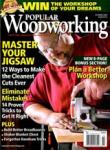Oct. 2006
Popular Woodworking
Nov. 2006
Popular Woodworking
Read David Calvo's articles in Popular Woodworking Magazine on learning how to carve wood. His first two articles
deals with carving tool selection, reshaping your edges for better tool control and using sharpening methods specific
for your wood carving tools.
Articles to follow will be on wood carving technique.

|
|
Learning the Fundamentals of Wood Carving at Calvo Wood Carving School
If I caught your attention with the title of this article then the likelihood is high that my wood carving classes and workshops might be just the thing you are looking for. In the old days, the cabinetmaker was also an able woodcarver as well. t allowed him to add colorful details that create a signature so that everyone knows from that moment on that it was done by your hands. These details become the key to the difference between commercial work and work that becomes heirloom quality, handed from one generation to the next.
Walk with me for a moment and let me share my perspective with you. Most woodworking projects are geometrical in nature. Sure we add hardwoods, nice moldings, beautiful joints, carefully crafted doors and a superfine finish but what one really responds to is the overall design and details.
The most important fundamental principle of design is contrast, where straight lines are complimented with curve lines. We live in a world of contrasts where opposites meet. Night-day, land-ocean, rough-smooth, men-women, and near-far are all a part of the environment around us. Why is this important? It is because this contrast in our environment is what evokes feeling in us. We respond to it like we respond to the beauty in a face. Working with woodcarving in this same way brings out the idea of contrast in your work and thus evokes a response in the observer. Have you ever gone to a museum where the simplest of objects strikes a cord of beauty in you. Why? Because they were carefully designed with the elements of contrast in mind.
Woodcarving is totally built on curves, so it is a natural contrast to the straight lines of your woodworking projects. Maybe now you see the puzzle that I have been trying to assemble. If this makes logical sense to you then it is completely on this premise that I will describe what we are going to do in my exciting beginners woodcarving workshops. These workshops will give you a solid foundation in all aspects of woodcarving. I went through an apprenticeship, was taught by European masters and I am happy to share my knowledge and information with you. In fact, I get great satisfaction out of seeing someone light up with the same enthusiasm I have for woodcarving.
We will explore the types of wood best for woodcarving and the important steps in designing your ideas. We will look closely at sharpening, a critical aspect of a good woodcarving tool. We will explore how to handle the woodcarving tools and move through the different stages of carving, from roughing out to delicate detailing. You don't need to be a physical giant to handle carving tools: it is all in the technique. This is a hands-on class where you can learn, at your own pace, skills that will enhance your carving ability for years of success and enjoyment. My woodcarving classes and workshops will shift you from the feeling that you are approaching woodcarving with no clear direction or reference points, to the knowledge that you are beginning to acquire the skills and control akin to a professional woodcarver.
|






